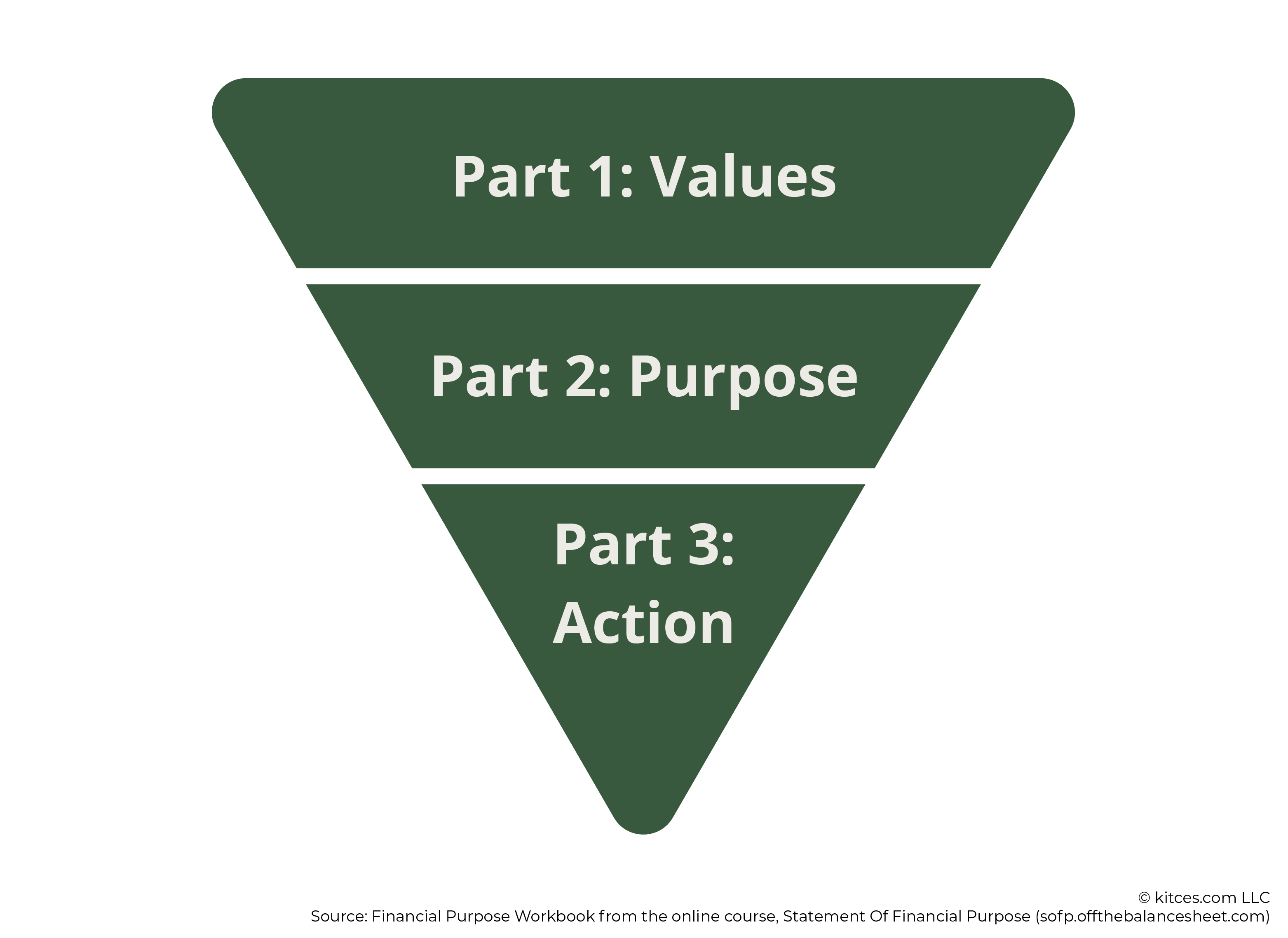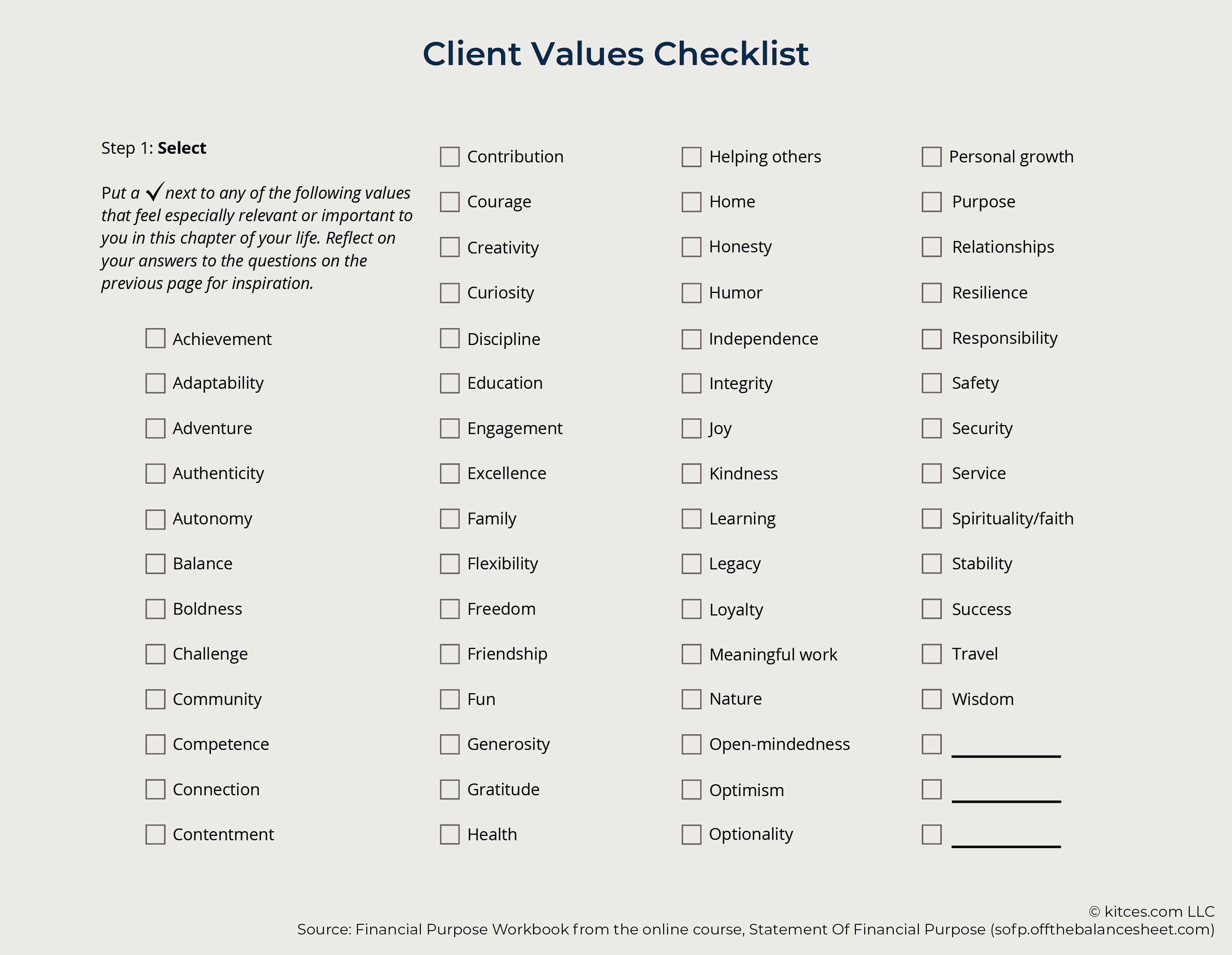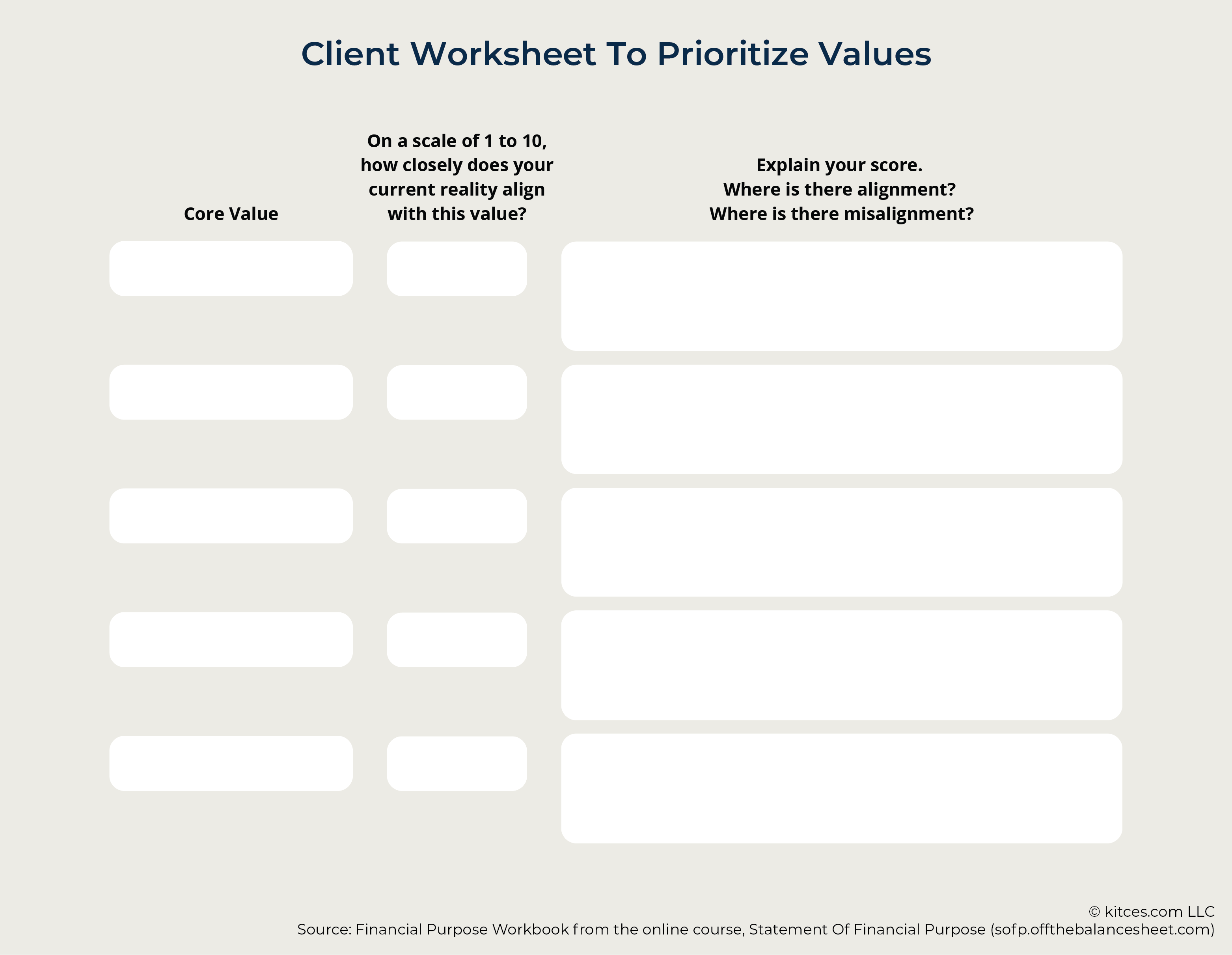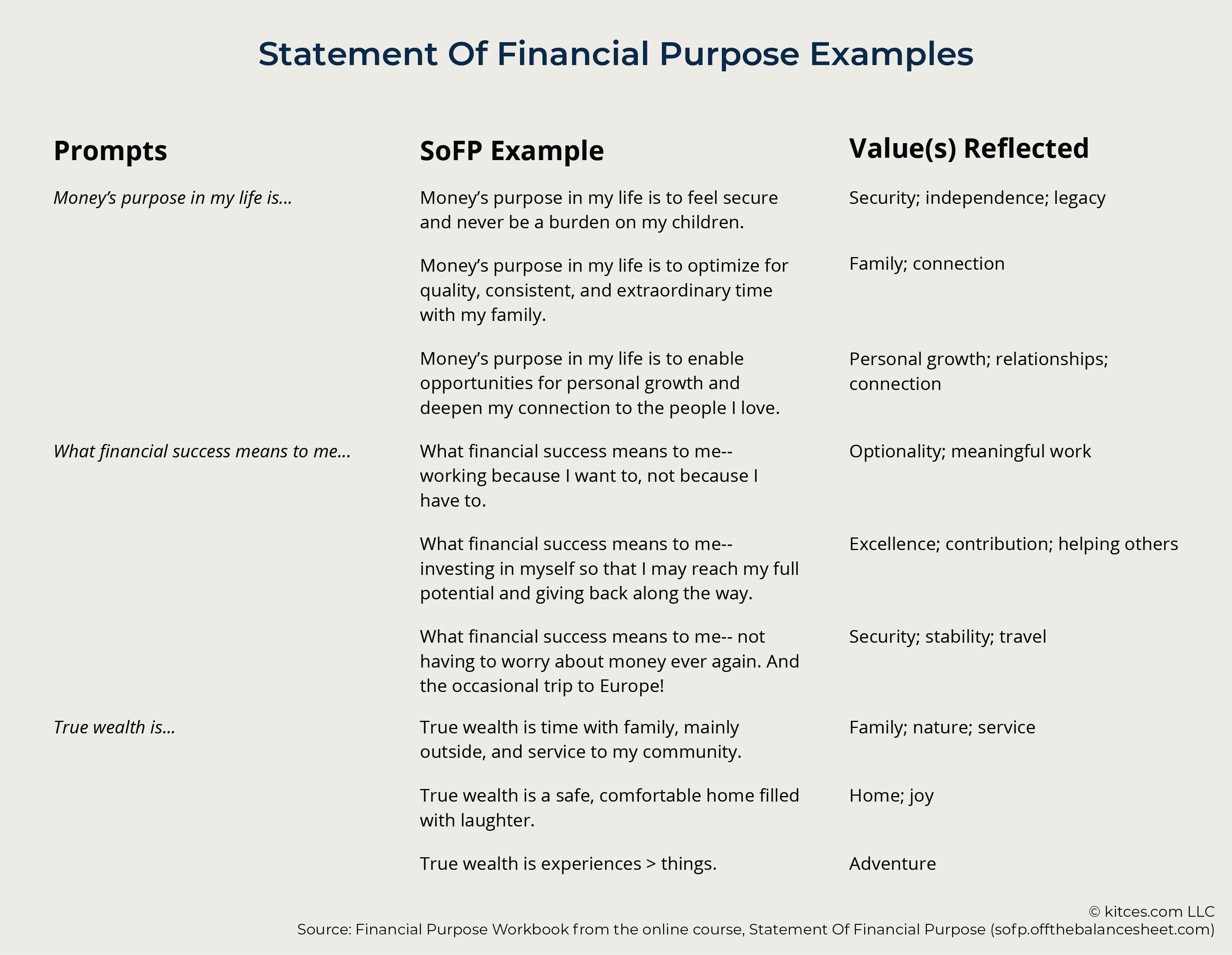Executive Summary
In the early days of financial planning, serving clients often meant developing transactional relationships focused on facilitating trades and selling insurance. Over time, advisors shifted toward more analytical approaches, such as investment management and retirement planning. Today, the industry has evolved further, with a growing emphasis on aligning financial decisions with clients' personal priorities and life goals. While this shift from numbers-based strategies to a more holistic, values-driven framework has opened the door to deeper, more meaningful conversations, it also presents a challenge for clients who may struggle to define their values or articulate a sense of purpose.
In this article, Jeremy Walter, founder of Fident Financial, and Andy Baxley, founder of Two Trails Financial Planning, discuss how advisors can follow a 3-part framework to help clients craft an informative, values-based statement of financial purpose.
The process begins by helping clients define their core values. This can involve asking reflective questions, such as "What does a perfect day look like to you?" or "How do you define success, security, and a life well-lived?" These questions encourage clients to uncover important themes – such as business growth, building a legacy, or prioritizing simplicity and family time – that guide their decisions. Typically, these values fall into 2 categories: realized values, which are already present in a client's life, and aspirational values, which represent qualities they want to embody. Advisors can then ask follow-up questions to further explore and deepen these themes, helping clients gain even greater clarity.
Once the client's values have been established, the next step is to articulate a statement of financial purpose – a concise expression that captures the "why" behind the client's financial decisions. This statement should go beyond superficial goals or what the client believes they should say, instead reflecting their true, deeply held priorities. Advisors play a crucial role here by helping clients draft, refine, and finalize a statement that feels authentic and actionable. This statement of financial purpose serves as an anchor for the client, providing clarity and direction as they make future financial decisions.
After the statement of financial purpose is created, the focus shifts to taking action. Advisors can help clients use their statement as a guide for assessing financial goals – both existing and future ones. Clients can reflect on whether their current goals are helping them get closer to living out their values or whether they need to revise their plan to better reflect what truly matters. The statement can also be used to establish new goals, ranging from more immediate, short-term objectives to larger, more ambitious stretch goals that, while challenging, may ultimately be more fulfilling. As clients begin to articulate and live by their values, advisors can revisit the statement periodically to ensure it remains relevant and aligned with evolving goals, and to assess whether adjustments are needed to better reflect their client's reality.
Ultimately, the key point is that understanding a client's values and purpose can unlock deeper, more meaningful financial planning conversations, enabling more fulfilling client discussions and allowing clients to do more with their money. And by aligning financial decisions with a clear statement of purpose, clients can foster a more intentional and meaningful relationship with their wealth!
There is a growing awareness in the financial planning profession that the most impactful advice often goes beyond the numbers. Increasingly, financial advisors recognize that their most meaningful work stems from a comprehensive understanding of their clients' personal and financial priorities and motivations. This approach aims to position money as a means to an end, enabling clients to minimize regrets, realize their authentic ambitions, and ultimately build fulfilling and satisfying lives.
 No matter what it's called – financial life planning, Financial Planning 3.0, or simply "financial planning done right" – the key objective and insight remain consistent: helping clients connect their money with their values and recognizing that a deeply felt sense of purpose is essential.
No matter what it's called – financial life planning, Financial Planning 3.0, or simply "financial planning done right" – the key objective and insight remain consistent: helping clients connect their money with their values and recognizing that a deeply felt sense of purpose is essential.
This shift in focus from a strictly technical planning analysis to a more values-driven examination of a client's goals can significantly transform not only a client's financial plan but also their overall approach to life. By understanding and aligning financial advice with a client's core values, financial advisors can help create more meaningful and satisfying outcomes for their clients.
To facilitate these transformative conversations with their clients, advisors can use a process that focuses on 3 key elements: Values, Purpose, and Action. These elements are addressed with the following approach:
- Asking questions and engaging in activities to uncover client values
- Creating a Statement of Financial Purpose
- Planning for meaningful and purposeful action
By using this Values → Purpose → Action framework, financial advisors can help their clients create financial plans that not only look good on paper but also feel deeply satisfying and aligned with their core values. Advisors have the flexibility to implement this approach either in a single meeting or over a series of meetings, depending on their clients' needs and preferences. Additionally, some advisors may prefer to assign certain aspects of this process as client pre- or post-work, encouraging clients to reflect on their values or complete exercises outside the meeting itself.
Part 1: Values
Understanding a client's personal values is fundamental to creating a financial plan that truly resonates with their deepest aspirations and motivations. A structured approach can help advisors uncover these values through thoughtfully crafted questions and engaging activities.
Defining Values
Personal values act as benchmarks, helping individuals gauge what constitutes a successful and fulfilling life. Before having these conversations with clients, it can be helpful for advisors to remember that values can be sorted into 2 categories: realized and aspirational.
Realized values are those already evident in a client's life, while aspirational values represent ideals they hope to embody more fully. Both are equally important to consider in the financial planning process. In fact, one could reasonably argue that aspirational values are even more important to consider, given that this is where room for improvement is to be found.
For example, a working parent with young kids has identified their top 3 stated values as family, health, and meaningful work. As every parent knows, it can be challenging to fully live up to one's values with so many competing priorities. This person may be fully satisfied with their ability to fulfill their obligations as a parent and a professional (realized values), yet feel disappointed by the state of their health (aspirational value). This disconnect opens the door to potential planning opportunities, such as hiring a personal trainer, installing a home gym, or hiring out certain household tasks to free up time for exercise.
Preparing Clients For The Conversation
Before diving into the values discovery process, it's crucial to set the stage appropriately. After all, clients may not be expecting to have these kinds of qualitative conversations with their financial advisor.
The dialogue below offers one way that advisors can introduce the process to clients:
As a financial advisor, I've found that I do my best work for clients when I've achieved an understanding of what, and who, is most important to them.
My greatest hope for our work together is that you will feel empowered to use money as a tool for living the best possible version of your life, however you envision that.
Before I review any numbers or offer recommendations, I would like to walk you through a few questions and a couple of exercises to establish that foundation. How does that sound?
Assuming the client has agreed to move forward, advisors can begin with 4 questions, discussed in the following sections. Each question is designed to approach the topic of values from a slightly different angle.
While these questions can be introduced during a client meeting, many advisors have found it helpful to send questions in advance. This gives clients who need time to reflect the opportunity to provide more thoughtful and comprehensive responses, ultimately leading to more productive discussions during the meeting.
Values Questions And Ensuing Discussion
The main goal in the first stage of the process is simply to identify values that are important to each client. It is normal for clients to highlight 10 or more values on their list (which is perfectly fine because, in the next stage, advisors will help clients focus on distilling their values down to the ones that feel most essential to them).
The following 4 questions can help advisors understand their clients' values:
- Vision of perfect. Describe your perfect day in vivid detail. Where are you? What are you doing? Who are you with?
- Definition of success. How do you define success in this chapter of your life?
- Security. When it comes to your personal and financial life, what do you need to feel confident and secure?
- Life well-lived. Imagine you're in the final hours of a rich and fulfilling life. From this vantage point, how would you describe a life well-lived?
For example, let's imagine that an advisor's client, Cindy, has given the following answer to Question #1 about her vision of what 'perfect' looks like:
I'd wake up early in our little mountain cabin. John and I would have coffee on the porch, just soaking in the quiet. Then we'd head out for a family hike; Emma and Jake would always race ahead. They love being the first to spot wildlife.
We'd have a picnic lunch with an amazing view. Maybe some kayaking in the afternoon? The best part is the evening, though: campfire, s'mores, and lots of laughs. We'd end the night stargazing, all cuddled up together. Just being in nature with my family, away from all the noise; that's my idea of perfect.
Upon hearing Cindy's answer, the advisor might note the following values: family, nature/outdoors, quality time, simplicity, peace/tranquility.
When posed with Question #2, Cindy's husband, John, has this to say:
Success for me right now is about striking the right balance. It's growing my business while still being present for my family's important moments. It's using our resources not just for our own comfort but also to make a real difference in our community.
Success means setting a good example for Emma and Jake, showing them the value of hard work, integrity, and giving back.
Ultimately, it's about feeling fulfilled in my career, nurturing strong family bonds, and leaving a positive legacy that extends beyond just financial wealth.
As the advisor listens to John's response, they write: balance, business growth, legacy, community.
Once the client has answered a given question, it is helpful to encourage them to go deeper with follow-up questions and prompts. The following are some examples:
- What was it like thinking through your answer to this question?
- Did anything surprising or unexpected come up as you answered the question?
- Was there anything in your partner's answers that surprised you? (if applicable)
- Do you notice any values coming through in your answers? If so, which ones?
- Why is that important to you?
- Tell me more about...
- I'm very curious to learn more about...
In addition to asking thoughtful follow-up questions, the advisor's job is to listen for the values coming through in their client's answers.
Finally, after all of the questions have been answered, it's helpful to review a comprehensive list of values that were identified through the client's answers and then to ask the client to note any that feel especially important to who they are. The advisor may contribute here by relaying the values they heard come through in the clients' answers.
Sharing a list (like the worksheet shown below, from the Financial Purpose Workbook) with clients can help them consider important values that might not immediately come to mind.
The Power Of Prioritization
While the initial questions may uncover a variety of personal values, it's beneficial to have clients narrow their focus to 3–5. This level of prioritization encourages clients to identify the core principles that truly define who they are and who they aspire to become.
For clients struggling with this narrowing process, advisors can ask them the following questions:
- Imagine you could only honor 3 of these values for the rest of your life. Which would you choose?
- Consider which values, if fully lived, would make you feel most fulfilled and proud.
- Reflect on moments when you felt most alive and aligned. Which values were you honoring?
- Think about the legacy you want to leave. Which values are central to that vision?
- Ask yourself, "If my children or loved ones were to describe my core values, what would they say?"
These questions can help clients dig deeper and connect with their most fundamental values rather than simply selecting what sounds good or socially desirable. The graphic below shows another worksheet from the Financial Purpose Workbook that can help clients organize their thoughts and prioritize their values.
Assessing Values Alignment
The final step in Part 1 of the process involves asking clients to assess how closely their current lived reality aligns with each of their chosen values. This exercise helps identify areas where adjustments may be needed to bring a client's financial decisions and overall lifestyle into better alignment with their core values.
Questions to consider during this alignment assessment exercise include:
- In what ways is your current reality aligned with this value?
- Where is there room for improvement? And what might that improvement look like?
- What has kept you from achieving alignment with this value? And how might you overcome this obstacle moving forward?
- Which value feels most important when it comes to achieving greater alignment?
This values discovery and alignment process lays a strong foundation for creating financial plans that are deeply meaningful and motivating to clients. However, knowing one's values is just the first step. The next challenge is to translate these values into a clear sense of purpose that can guide financial decisions and life choices.
Part 2: Purpose
As clients reflect on the gaps between their values and their current reality, they begin to envision how they want their lives to look and feel. This vision forms the basis of their purpose – the driving force behind their financial goals and decisions.
Advisors can play a key role in helping clients articulate this purpose by developing a Statement of Financial Purpose (SoFP), bridging the gap between abstract values and practical financial decision-making.
Crafting A Statement Of Financial Purpose
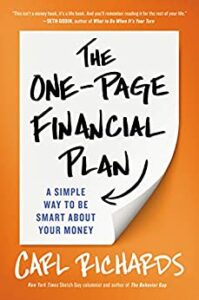 A Statement of Financial Purpose (SoFP), a term first coined by Carl Richards in The One-Page Financial Plan, is a concise expression of what a client ultimately aims to accomplish with their money. It's the "why" behind their wealth and financial choices. A strong SoFP will consist of no more than 1–2 sentences, as longer statements may lose focus and impact.
A Statement of Financial Purpose (SoFP), a term first coined by Carl Richards in The One-Page Financial Plan, is a concise expression of what a client ultimately aims to accomplish with their money. It's the "why" behind their wealth and financial choices. A strong SoFP will consist of no more than 1–2 sentences, as longer statements may lose focus and impact.
Because clients may not be familiar with this concept, it's helpful to first have a conversation to establish a foundation before asking them to create their own SoFP. The advisor might lead the dialogue with something like this:
Now that we've identified your core values, I'd like to introduce a tool that I use with clients to ensure that these values are reflected in your financial decisions and all of the work we will do together. It's called the Statement of Financial Purpose.
Think of your Statement of Financial Purpose as the "why" behind your wealth, a simple 1–2 sentence statement that will provide clarity whenever we're navigating big decisions and considering the tradeoffs.
At this stage, it can also be helpful to share a few examples of Statements of Financial Purpose to ensure that the client fully understands the concept.
To help clients begin crafting their own SoFP, consider having them choose between the following sentence prompts:
- Money's purpose in my life is…
- What financial success means to me:
- True wealth is…
Of course, while sentence prompts can help to get creativity flowing, the client should be free to structure their SoFP in a way that feels most authentic to them. It's important to encourage clients to express themselves honestly, as the most effective SoFPs will reflect their true aspirations, not what they think they should say. Ultimately, SoFPs that both guide and inspire real-world decisions will be the most effective in helping clients achieve their goals.
To reduce the pressure of drafting an SoFP on the spot, it can be helpful to give clients a 5–10-minute break to create their first draft. In an in-person meeting, the advisor might leave the room. In a virtual setting, both the advisor and client could turn off their cameras for a few minutes.
Alternatively, this exercise can be assigned as homework to be completed between meetings. In this case, the advisor can begin the next meeting by discussing the client's first draft.
Here's how all of this might sound in practice:
If you're up for it, I'd like you to write a first draft of your Statement of Financial Purpose. Feel free to use the examples and sentence prompts I shared for inspiration, but remember that your Statement should reflect who you are and what you want to accomplish with your money. So don't hesitate to deviate from the examples and prompts to create something that feels authentic to you.
And keep in mind, this is just the first draft, and first drafts are rarely perfect. We'll work together to refine what you've written until it feels just right for you.
When working with a couple, it's often helpful to have each person write their own first draft of the couple's SoFP. The advisor can then help the couple merge the essential components of their respective SoFPs into a shared statement that resonates with both individuals. In some cases (e.g., couples who keep their finances separate), each person may prefer to maintain their own separate SoFP. While this isn't necessarily an issue, crafting a shared SoFP is encouraged whenever possible, as it can be a unifying and gratifying experience.
Once the first draft has been completed, the next step is to engage in some guided reflection. Here are a few questions and prompts to facilitate the discussion:
- Tell me about your experience writing your first draft. Which aspects felt easy, and which were more challenging?
- How are you feeling about your first draft overall?
- Which parts do you feel good about? Which parts could use some work?
- Which of your core values are reflected in your statement?
- Which of your core values are not reflected in your statement? Would it be helpful to brainstorm ways to incorporate them?
- Do you have any ideas for how we might improve your statement to make it more motivating or clarifying?
After reflecting on these questions, the client and advisor can work together to modify and refine the draft until the client is happy with their statement.
It's important to remember that while writing a Statement of Financial Purpose might seem simple, it's not always easy! If the client is struggling, it's perfectly fine to offer as much guidance as needed or to give them additional time to craft their statement.
Example: A Values-Aligned Statement Of Financial Purpose
To illustrate how individual values can be woven into a cohesive Statement of Financial Purpose (SoFP) for a couple, let's consider Cindy and John's case from earlier.
Cindy's perfect day centered around family time in nature, emphasizing tranquility, outdoor activities, and quality time with loved ones away from daily stresses.
John's definition of success focused on balancing professional growth with family presence, making a community impact, and setting a positive example for their children.
By considering both perspectives, Cindy and John might craft the following SoFP:
True wealth for us is the ability to balance professional growth and community impact with treasured family time in nature. We aim to use our resources to nurture strong family bonds, drive positive change in our community, and create a legacy of meaningful experiences and values for our children.
Or, if they prefer a more concise version, it may look like this:
True wealth is balancing professional impact with cherished family time in nature, creating a legacy of meaningful experiences and positive community change.
Both statements successfully blend Cindy's desire for family time in nature with John's aspirations for professional success and community impact. They address their shared value of family while also incorporating their individual priorities.
The SoFP provides a clear guide for financial decision-making, as we will see in part 3, Action.
Part 3: Action
The process of uncovering values and creating a Statement of Financial Purpose (SoFP) can be inspiring, perhaps even transformative, but its true power lies in translating these insights into concrete, real-world action. In the final stage, we draw upon our clients' core values and sense of purpose to create tangible and authentic goals.
From Values To Action
Having identified what truly matters to the client, the conversation shifts to taking action. What will the client do to honor their values and live up to their Statement of Financial Purpose? The goal here is to empower the client and increase their sense of efficacy by focusing on where the things that matter most to clients intersect with the things they can directly control.
When helping clients determine what values-aligned goals might look like, it's important to focus on both short-term (<5 years) and long-term (5+ years) objectives.
Short-term goals are typically more immediately actionable, helping to build momentum and provide quick wins. For Cindy and John, a short-term goal might be to "Plan a 2-week family vacation to a national park within the next year".
Long-term goals represent loftier ambitions and can be highly motivating. A long-term goal for Cindy and John could be "Renovate our family cabin, creating more livable space so that our family may stay connected for generations to come".
Guiding Clients Towards Meaningful Goals
To help clients articulate goals that truly resonate with their values and SoFP, consider these questions and tips:
Questions to ask:
- What about that goal feels important to you?
- What would you be most likely to regret not doing?
- What change would make the biggest positive impact on your life?
- What is something you'd love to try if you knew you couldn't fail?
When guiding clients through the process of setting meaningful goals, financial advisors can employ several best practices to ensure the experience is both productive and inspiring.
Reflecting on Values and Purpose. Encourage clients to revisit their identified values and Statement of Financial Purpose (SoFP) when considering potential goals. This reflection helps ensure that the goals they set are truly aligned with what matters most to them.
Helpful language: "Let's take a moment to review the values we identified earlier and your Statement of Financial Purpose. How do you see these reflected in the goals we're discussing?"
Revisiting Alignment Discussions. Many ideas from the conversations in the initial "Values" stage will likely be relevant when setting goals. Remind clients of insights or aspirations they shared earlier in the process. This can help spark new ideas or reinforce the importance of certain goals.
Helpful language: "Remember when you mentioned [specific insight from earlier discussion]? How do you think that relates to the goals we're setting now?"
Balancing Stretch Goals and More Easily Achievable Ones. Prompt clients to consider a mix of stretch goals alongside easily achievable ones. This balanced approach helps maintain motivation through quick wins while also inspiring clients to reach for more ambitious targets.
Helpful language: "What's a goal that feels easily achievable to you? Now, what's a goal that would really stretch you?"
Offering Take-Home Reflection. Some clients may need more time to fully explore their goals and options. Offering the option to take home the questions asked in the "Action" stage for further reflection can be invaluable, allowing clients to ponder their objectives in a comfortable, pressure-free environment.
Helpful language: "I know we've covered a lot today. Would you like some time to reflect on these ideas at home before we finalize your goals?"
Emphasizing Open-Ended Brainstorming. It's crucial to emphasize that there are no 'right' answers when it comes to setting personal financial goals. This is fundamentally a brainstorming session, and clients should feel free to explore various possibilities without fear of judgment.
Helpful language: "Don't worry about practicality just yet. Let's brainstorm freely and see what ideas emerge."
Aiming for Specificity. When articulating goals, specificity is key. Vague objectives like "travel more" lack the clarity and direction needed for effective planning. Encourage clients to formulate more precise goals. For instance, instead of "travel more," you might suggest "visit all 15 US national parks by 2035". This level of detail not only makes the goal more tangible but also provides clear parameters for measuring progress and success.
The Importance Of Accountability And Revisiting Values
Financial advisors play a vital role in holding clients accountable to their goals and values. Regular check-ins can help track progress and adjust strategies as needed. It's also important to periodically revisit clients' values and SoFP. Our priorities and circumstances can shift over time, and financial plans should evolve accordingly. For instance, as Cindy and John's children grow older, their focus might shift from family vacations to college planning or supporting their children's entrepreneurial endeavors.
The Values → Purpose → Action framework offers a powerful approach to financial planning that goes well beyond a purely quantitative approach to financial planning. By helping clients uncover their core values, articulate a clear purpose for their wealth, and take meaningful action, advisors can create financial plans that resonate deeply with their clients' true aspirations. This process not only leads to more satisfying outcomes for clients but also fosters stronger, more enduring advisor-client relationships.
As the financial planning profession continues to evolve, the ability to provide this level of personalized, purpose-driven guidance will become increasingly valuable. By embracing this approach, advisors can differentiate themselves in a crowded market, deliver more impactful advice, and help clients achieve not just financial success but also a genuine sense of fulfillment. In the end, this is what truly exemplifies "financial planning done right" – empowering clients to use their resources in ways that align with their deepest values and contribute to a life well-lived.
Advisors interested in learning more are invited to check out the online course "Money and Meaning: A Guide to Purposeful Financial Planning and Deeper Client Relationships." This course, developed in collaboration with Carl Richards, was launched in early 2024 to support advisors in implementing these concepts in their practice.



